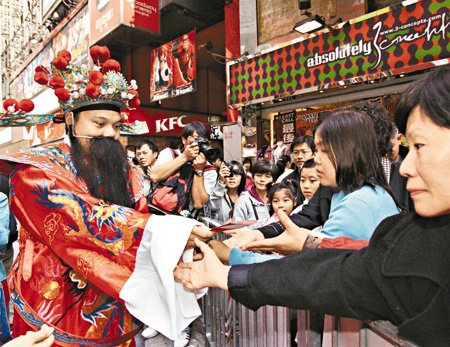
 |
Spring Festival is the most ceremonious traditional festival with the longest history in China. Taiwan, which faces Fujian province across the sea, is similar to Chinese mainland (especially the south region in Fujian province) in terms of history, culture, social and folk custom as well as ancestry. Activities carried out by Taiwanese during Spring Festival would start with "eating year-end dinner" on the 16th day of the 12th lunar month. They would be busy doing spring cleaning, neatening courtyard and living room, and preparing special foodstuffs for Spring Festival before New Year's Eve.
On the 24th day of the 12th lunar month, people would "send off gods to the heaven", just as the tradition of "sacrificing to the Kitchen God" in the south of Fujian province. The offerings must contain "Sweet Round Ball" (rice dumping) which is stuck to the kitchen so that the Kitchen God can "pass words of praise to the heaven and drop swearwords". People would also do spring cleaning on this day, so as to sweet away all "misfortunes" and greet the New Year.
On New Year's Eve, every family would stick spring festival scrolls implying auspiciousness, good luck and fortune-greeting, etc. to their doors, windows, barns, piggeries, wells and other places, and then display offerings, incense and candles on the credence, so as to sacrifice to their ancestors and greet them to "spend Spring Festival" at home. They would prepare offerings such as oranges, sweet Miguo (rice cake), spring rice and New Year Gift Money before the nightfall. "Spring Rice" is a full bowl of rice with a paper-cut chinese character "春" (Spring) inserted on it. Also, they would keep upright two sugar canes with leaves and roots behind the front gate. The sugar canes are called "Long-life Sugar Canes" which imply length and sweetness and "bringing auspiciousness to the family". When having New Year Dinner, all family members would sit around a cook stove which is placed under the square table together with a new palm fan, each of which is pasted with the character "春" (Spring) and "福" (Blessing) made of red paper.
Such food would be offered at New Year Dinner as follows: fish balls and meat balls that mean unity; chicken which means "family flourishing"; longevity-symbolizing leek; and various fried foodstuff, rice dumplings and rice cakes with local features, including "tortoise-shaped rice cake with sweetened bean paste" (a kind of rice cake pressed in tortoise-shaped wooden mold and containing sweetened bean paste) which implies longevity.
On the first day of the first lunar month, people would get up early in the morning, do the washing, dress up, and then carry out activities such as paying New Year call to each other with blessing, visiting relatives and friends, and going sightseeing in parks. On the second day, new son-in-law would bring his wife to visit her original family. The third day is regarded as an inauspicious day by Taiwanese who would stay at home instead of going out. From the fifth day on, many people would begin to run business or return to work.
Link : | China Daily | Chinaculture.org |